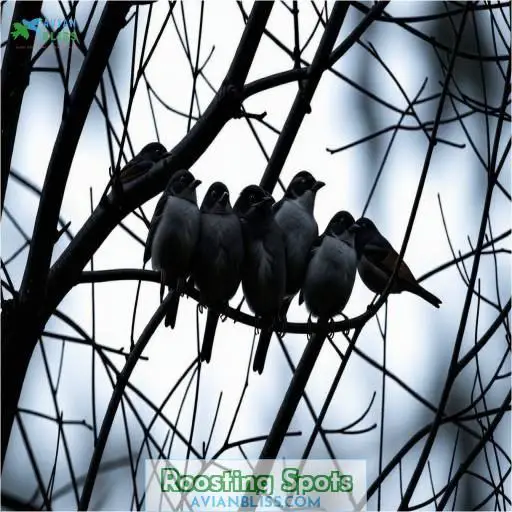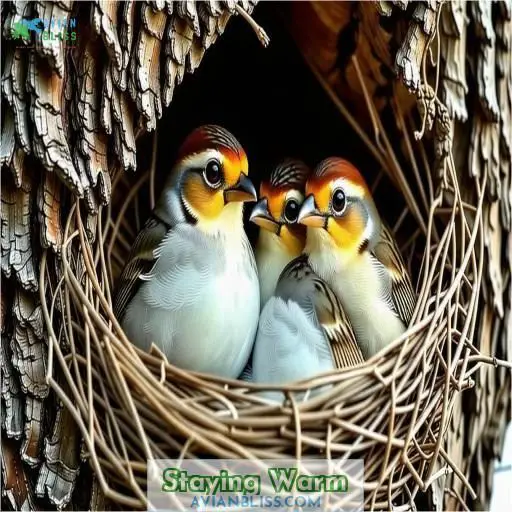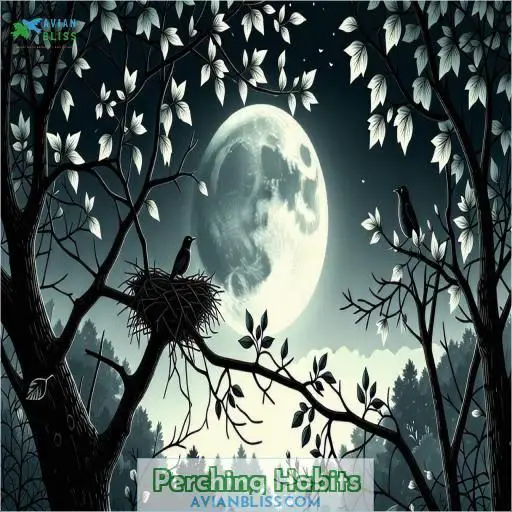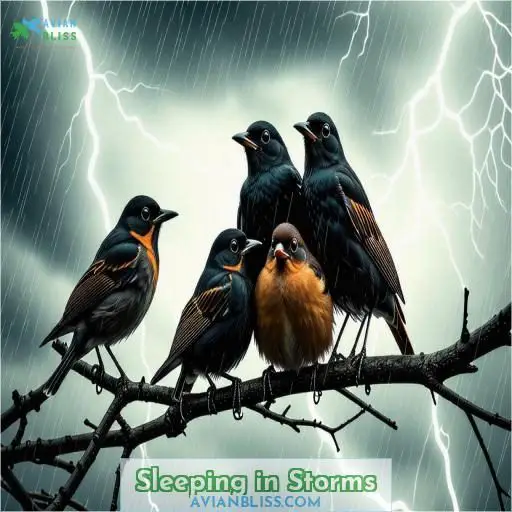This site is supported by our readers. We may earn a commission, at no cost to you, if you purchase through links.
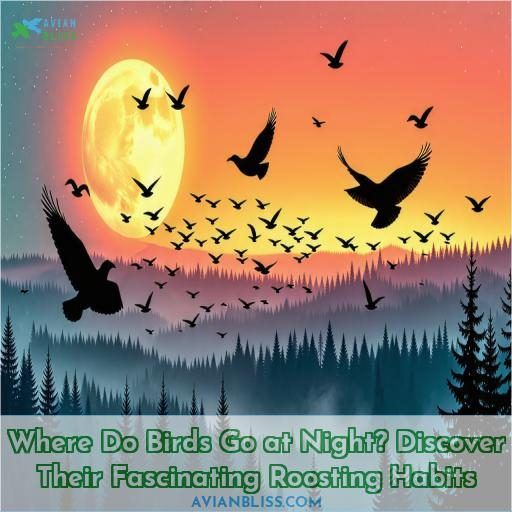
Woodpeckers and bluebirds snuggle into cozy tree cavities.
While songbirds perch on branches, tendons locking their feet for a secure sleep.
In open areas, birds face the wind for shelter.
During nesting season, they may even bunk in their nests.
Heat conservation is key – feathers provide insulation, and ducks tuck bills into plumage.
Hummingbirds sleep upside-down or enter torpor to conserve energy.
Uncover more intriguing details about birds’ nighttime retreats as we explore their engrossing world.
Table Of Contents
- Key Takeaways
- Where Do Birds Go at Night?
- Roosting Spots
- Nesting Habits
- Sleeping Positions
- Staying Warm
- Perching Habits
- Nighttime Singing
- Sleeping in Storms
- Diurnal Vs. Nocturnal Birds
- Bird Napping
- Frequently Asked Questions (FAQs)
- Do birds sleep in the same place every night?
- Where do backyard birds go at night?
- What time do birds go to sleep at night?
- Where do birds sleep when it rains?
- Do birds sleep while flying?
- How do birds avoid falling off perches while sleeping?
- Can birds see in the dark?
- Do birds dream like humans?
- How do birds stay safe from predators at night?
- Conclusion
Key Takeaways
- Birds use various roosting spots at night, such as tree cavities, dense foliage, and man-made structures, to find shelter and avoid predators.
- Birds employ strategies like tucking their heads and feet into their feathers, burying their bills in their back feathers, and pulling a leg into their plumage to conserve warmth during cold nights.
- Nocturnal birds like owls, nighthawks, and nightjars are active at night and sleep during the day, while diurnal birds are active during the day and sleep at night.
- Some birds, like frigatebirds, can sleep while flying by keeping one eye open and half their brain active to stay alert for predators.
Where Do Birds Go at Night?
Birds have various roosting habits at night, depending on their species and environment. Many birds sleep in nests, tree cavities, dense foliage, or man-made structures to stay warm, safe, and sheltered from the elements. Some birds, like owls and nighthawks, are nocturnal and active at night while sleeping during the day.
Roosting Spots
When looking for roosting spots at night, you’ll often find woodpeckers and bluebirds sheltering in holes in trees. In open areas, birds tend to roost while facing into the wind.
Woodpeckers and Bluebirds Often Use Holes in Trees
Woodpeckers and bluebirds often call tree cavities home, using old woodpecker nest holes as cozy roosts.
These natural tree cavities provide shelter from predators and harsh weather, making them ideal spots for birds to sleep at night.
Bluebirds readily adapt to these holes, building their nests inside and raising their young in the safety of the tree.
Nesting and roosting go hand-in-hand for these cavity-dwelling birds.
Facing the Wind in Open Areas
In open areas, birds often face the wind when roosting to conserve energy and avoid predators. This positioning provides protection from the elements and allows them to quickly take flight if needed. Diurnal birds, active during the day, will seek sheltered perches at night to rest and sing, choosing spots that offer both safety and comfort.
Nesting Habits
When nesting, birds use their nests as cozy shelters for incubating eggs and raising their young. However, once the chicks have grown and left the nest, parent birds typically abandon the nests and seek out different roosting spots for the night.
Nests Used for Incubating Eggs and Raising Young
Birds construct nests using various materials like twigs, grass, and feathers (Source). Nest building is an instinctive behavior that varies by species . Maintaining nests through repairs and cleaning helps prevent parasites and disease . Predators like snakes, raccoons, and cats pose risks to nests . Nests serve as sheltered spaces for eggs and chicks, but aren’t used for regular roosting .
Birds May Sleep in Nests During Nesting Season
During nesting season, birds may sleep in their nests to incubate eggs and care for their young. Specialized nest designs help regulate temperature for ideal egg development. Parent birds take turns sitting on the nest, with one keeping the eggs warm while the other searches for food. This devoted parenting ensures the survival of their offspring.
Parent Birds Leave Nests Once Young Are Old Enough
Once the chicks have fledged and can survive independently, parent birds abandon the nest they so diligently built and maintained.
The nest’s purpose has been fulfilled – providing a safe haven for the young to hatch and grow.
With their offspring now self-sufficient, the parents turn their attention to other essential behaviors like molting, foraging, and finding a suitable roosting spot for the night.
Sleeping Positions
You might observe passerines, or perching birds, sleeping while standing or sitting with their feet clasped around a branch. They enter a half-conscious state, allowing them to rest while remaining alert to potential threats.
Passerines Sleep Standing or Sitting With Feet Clasped
Passerines, the perching birds, have a unique way of sleeping while standing or sitting. Their feet clasp tightly around branches, thanks to a special tendon system. This allows them to doze off while maintaining a firm grip, even in a half-conscious state. Their ability to sleep standing is truly remarkable .
Entering a Half-conscious State to Rest and Stay Alert
As the sun sets, songbirds enter a half-conscious state to rest and stay alert.
Their brains remain partially active, allowing them to detect predators while enjoying a well-deserved slumber.
This unique adaptation guarantees their safety without sacrificing the restorative benefits of sleep.
Feathers fl■, beaks tucked, and eyes closed, birds drift into a state of peaceful alertness, ready to face the challenges of the new day.
Staying Warm
To combat chilly nights, birds employ ingenious strategies for retaining warmth. Their downy feathers act as exceptional insulation, while some species tuck their entire body into a tight ball, further trapping precious body heat. Ducks, geese, and swans go a step further, burying their bills deep into their back feathers to minimize heat loss.
Feathers Provide Insulation
Feathers play a critical role in insulating a bird’s body, aiding in heat retention (Source). The arrangement of feathers creates pockets of air that trap heat close to the bird’s skin, providing insulation against the cold . As a result, birds can maintain their body temperature even in lower external temperatures, guaranteeing their survival and comfort during the night .
| Feathers Provide Insulation | ||
|---|---|---|
| Traps Heat | Aids in Heat Retention | Ensures Comfort |
Tucking Into Themselves for Heat Conservation
To conserve warmth, birds tuck themselves into a tight ball, fluffing out their feathers to trap heat close to their bodies. This efficient insulation helps retain body heat and preserve energy, allowing them to maintain a stable temperature through the night. Tucking in provides a cozy, protected space for birds to rest and recharge.
- Fl■ feathers trap heat
- Tucked head and feet preserve warmth
- Compact posture minimizes heat loss
- Sheltered spots add extra insulation
- Staying warm helps birds thrive
Ducks, Geese, and Swans Burying Bills in Feathers
While resting, ducks, geese, and swans tuck their bills into their back feathers to conserve warmth. This behavior allows them to utilize their feathers for insulation and maintain body heat effectively during sleep. The strategic use of feather insulation is an essential part of their nighttime routines, enabling these birds to safeguard themselves from cold temperatures while they rest .
Birds Pulling a Leg Into Feathers for Warmth
Some bird species have intriguing methods for retaining heat during sleep, such as tucking a leg into their feathers. This leg posture helps them conserve energy and stay warm. By using insulation strategies like fluffing up their feathers and tucking a leg into their plumage, birds can effectively regulate their body temperature, ensuring a restful night’s sleep while maintaining warmth .
Perching Habits
Most songbirds are natural perchers, using their tendons and feet to clamp onto branches for roosting at night. Surprisingly, hummingbirds often sleep upside-down, and during cold spells, they enter a state of torpor to conserve energy.
Natural Perchers: Most Songbirds
Most songbirds are natural perchers, even while sleeping at night. Their feathers provide insulation, and they tuck into themselves to conserve heat. Ducks, geese, and swans bury their bills in their feathers, while some birds pull a leg into their plumage for extra warmth. Cavity nesters make limited use of nests for night roosts.
- Feathers offer insulation
- Tucking into themselves conserves heat
- Ducks, geese, and swans bury bills in feathers
Tendons and Feet Clamping Onto Branches
Birds perch by clamping their feet onto branches using tendon strength, which provides a secure grip for nighttime balancing.
Their foot positions and branch selection are critical for safety and comfort while sleeping.
Understanding these grip techniques is essential for comprehending birds’ roosting habits, ensuring their safety and freedom throughout the night.
This insight can help bird enthusiasts appreciate the fascinating perching habits of these remarkable creatures.
Hummingbirds Sleeping Upside-down
Hummingbirds, those tiny avian marvels, have a unique sleep habit – they snooze upside-down! Clinging to branches with their sharp claws, these diminutive dynamos tuck their beaks into their back feathers and drift off to dreamland. It’s a clever way for hummingbirds to conserve energy while staying safe from predators during their well-earned slumber.
Hummingbirds Entering Torpor During Cold Spells
Hummingbirds, those tiny feathered wonders, have a unique trick up their sleeve when the mercury drops – torpor. During cold spells, these high-octane flyers enter a state of deep sleep, lowering their body temperature to conserve precious energy. It’s nature’s way of helping them weather the storm and live to hum another day .
Nighttime Singing
One fascinating aspect of nighttime bird behavior is nocturnal singing, which serves purposes like territory establishment and mate attraction. With reduced noise pollution at night, some species like the European robin have been observed increasing their nighttime singing in urban areas.
Territory Establishment and Mate Attraction
As night falls, birds burst into song to establish their territory and attract mates. Their melodic calls echo through the darkness, serving as a beacon for potential partners. Singing behavior intensifies during breeding season, with males vying for the attention of females through their vocal prowess and persistence. This nocturnal communication is a
Reduced Noise Pollution at Night
Nighttime provides birds with a quieter environment to sing and communicate, reducing noise pollution. This allows them to establish territories, attract mates, and engage in social interactions more effectively. The reduced noise levels at night are especially beneficial for urban birds, as they face higher levels of ambient noise during the day.
European Robins Increasing Nighttime Singing in Urban Areas
European robins in urban areas adapt to altered environments influenced by urban noise pollution and nighttime urban lighting. Their nighttime singing reflects an intriguing aspect of avian behavior in urban areas, offering insights into the effects of urbanization on bird behavior. These birds demonstrate remarkable flexibility, overcoming the challenges posed by human-altered environments with their captivating songs as they prosper in urban settings.
- Adaptation to urban noise pollution
- Response to nighttime urban lighting
- Resilience in singing in human-altered environments
- Insights into the effects of urbanization on bird behavior (Source)
Sleeping in Storms
When storms approach, birds seek refuge in sheltered spots to protect themselves from the inclement weather. They may hunker down in tree holes, thick bushes, or man-made structures, tucking themselves in tightly to conserve warmth and avoid exposure to harsh elements.
Roosting in Sheltered Places
Birds have specific roosting preferences to avoid predators and weather. They select sheltered spots like dense foliage, tree cavities, and man-made structures. Some species roost communally for warmth and safety. Urban birds adapt by roosting on ledges, under bridges, and in buildings. Roosting is a critical behavior for birds to survive the night.
Taking Extra Precautions for Inclement Weather
When facing inclement weather, birds display excellent preparedness by carefully selecting roosts and shelter options. Their storm avoidance tactics include roosting in sheltered spots such as tree holes, thickets, or man-made structures. This strategic behavior helps them stay safe and protected during harsh conditions, showcasing their remarkable ability to adapt to challenging environments with foresight and resilience.
Birds May Predict and Fly Ahead of Storms
Birds have an uncanny ability to predict and fly ahead of approaching storms.
Their keen senses detect subtle changes in air pressure, temperature, and wind patterns that signal an impending storm.
Migratory birds often adjust their flight paths to avoid severe weather.
While resident birds may seek shelter in advance.
This weather-sensing skill helps birds find safe roosting spots before the storm hits.
Hunkering Down in Tree Holes, Thickets, or Man-made Structures
When storms approach, birds instinctively seek shelter in dense tree cavities, tangled thickets, or man-made structures like barns and sheds.
These hidden spots provide essential protection from wind, rain, and predators.
Woodpeckers and owls may roost in tree holes year-round, while other species temporarily hunker down until the weather passes.
Birds’ unique adaptations, such as specialized Bird Plumage and Camouflage, help them blend in with their surroundings, protecting them from predators and harsh weather conditions. Seeking shelter is a key survival strategy for birds facing harsh conditions.
Diurnal Vs. Nocturnal Birds
As we explore where birds go at night, it’s essential to understand the difference between diurnal and nocturnal species. Diurnal birds like most songbirds are active during the day and sleep at night, while nocturnal birds such as owls, nighthawks, and nightjars are active at night and rest during the daytime hours.
Diurnal Birds: Active During the Day, Sleep at Night
Most birds you see fluttering around during the day are diurnal, meaning they’re active when the sun is shining. These feathered friends:
- Sing their cheerful songs at dawn
- Forage for food in the afternoon
- Roost in trees or birdhouses at night
Diurnal birds sleep soundly while nocturnal birds like owls and nighthawks take flight. Discover the fascinating sleep habits of birds in their nests, cavities, and foliage retreats.
Nocturnal Birds: Active at Night, Sleep During the Day
While most birds are active during the day and sleep at night, some species have adapted to thrive in the darkness. Nocturnal birds, such as owls, nighthawks, and nightjars, hunt and forage under the cover of night. Their large eyes, keen senses, and camouflaged plumage help them navigate the world after sunset.
| Nocturnal Adaptation | Description |
|---|---|
| Night Vision | Nocturnal birds have large eyes and specialized retinas to see in low light conditions. |
| Silent Flight | Their feathers are designed to minimize noise, allowing them to approach prey quietly. |
| Acute Hearing | Owls have asymmetrical ears and facial discs that funnel sound waves to their ears. |
Some nocturnal birds, like nightjars, migrate at night to avoid predators and take advantage of cooler temperatures. Their unique adaptations make them masters of the night sky.
Examples of Nocturnal Birds: Owls, Nighthawks, Nightjars
Nocturnal bird behaviors are fascinating. Owls, nighthawks, and nightjars showcase remarkable adaptations. Their sleep patterns, foraging strategies at night, and vision in darkness are intriguing. Nighthawks, especially, exhibit unique nighttime behaviors, making them rulers of the night skies. Observing these nocturnal birds can provide insights into their secretive and intriguing world.
Bird Napping
Did you know that many birds take short naps throughout the day, keeping half of their brain active to watch for predators? Frigatebirds are even capable of sleeping while flying, leaving one eye open during their aerial slumbers.
Short Snoozes Throughout the Day
Bird napping is a common behavior among birds, involving short snoozes throughout the day. During these daytime sleeps, birds are able to keep half of their brain active for predator detection while still entering a half-conscious state to rest and stay alert. This adaptive behavior allows birds to maintain awareness of their surroundings even while taking much-needed breaks.
Half of the Brain Remaining Active for Predator Detection
Birds like ducks and frigatebirds can keep one half of their brain active while sleeping, allowing them to remain vigilant for predators. This unihemispheric slow-wave sleep enables them to rest while maintaining a level of awareness. Their brain activity alternates between the two hemispheres, ensuring they stay safe during their slumber .
Magnificent Frigatebirds Sleeping While Flying
Magnificent frigatebirds, known for their impressive aerial displays, have an extraordinary ability to sleep while in flight. These seabirds can enter a state of unihemispheric slow-wave sleep, allowing one brain hemisphere to rest while the other remains active for predator avoidance and navigation during nighttime migrations. Frigatebirds’ sleep patterns demonstrate their remarkable adaptations for survival in the open ocean.
Frigatebirds Keeping One Eye Open During Aerial Sleep
Frigatebirds, masters of aerial sleep, keep one eye open to stay alert for predators and navigate during migration.
This evolutionary adaptation allows them to rest half their brain at a time, ensuring survival and successful journeys.
By monitoring their surroundings with one eye, frigatebirds can avoid danger and maintain their course.
This is a proof of the wonders of avian brain function and sleeping patterns.
Frequently Asked Questions (FAQs)
Do birds sleep in the same place every night?
Birds’ bedding behaviors‘ bewildering variety varies vastly. Certainly, some cozy in crevices nightly, nestlings notwithstanding. Others opt for open, advantageous overnight oak outposts. Patterns prove pliable for predator protection.
Where do backyard birds go at night?
At night, you’ll find backyard birds perched securely on tree branches or nestled in cozy birdhouses and tree cavities, sheltered from predators and the elements.
What time do birds go to sleep at night?
Unlike humans, birds don’t follow a strict sleep schedule. As daylight fades, they’ll instinctively seek out safe roosting spots to tuck in for the night.
Where do birds sleep when it rains?
When nature’s tears fall, our feathered friends find solace in the embrace of dense foliage, thickets, and manmade structures, hunkering down until the storm passes.
Do birds sleep while flying?
Yes, some birds like frigatebirds can sleep while flying, keeping one eye open and half their brain active. This unihemispheric slow-wave sleep lets them stay alert for potential threats.
How do birds avoid falling off perches while sleeping?
Birds masterfully grip branches with clenched feet while asleep. Their tendons naturally lock into perches, keeping them securely in place. It’s a clever evolutionary trick for night-time roosting without tumbling off!
Can birds see in the dark?
You’re perplexed about birds’ night vision, aren’t you? Well, most birds can’t see in total darkness, but their eyes are optimized for low-light conditions, granting them impressive night vision compared to humans.
Do birds dream like humans?
Like a waking dream, birds’ sleep patterns remain an enigma. While scientific evidence suggests they do experience REM sleep akin to humans, the depth of avian dreamscapes is still unknown, leaving us to ponder their nocturnal reveries.
How do birds stay safe from predators at night?
You’ll see birds seek out dense foliage, tree cavities, and sheltered spots to hide from predators as night falls. Smart birds know secluded roosts are key for peaceful slumber.
Conclusion
Brimming with curiosity, you’ve explored the intriguing realm of avian roosting habits. From cozy tree cavities to gravity-defying slumbers, birds’ nighttime retreats exhibit an array of adaptations designed for survival. As darkness falls, keep an eye out for these feathered friends seeking shelter, warmth, and respite, for where do birds go at night? Nature’s ingenious designs await your discovery.


